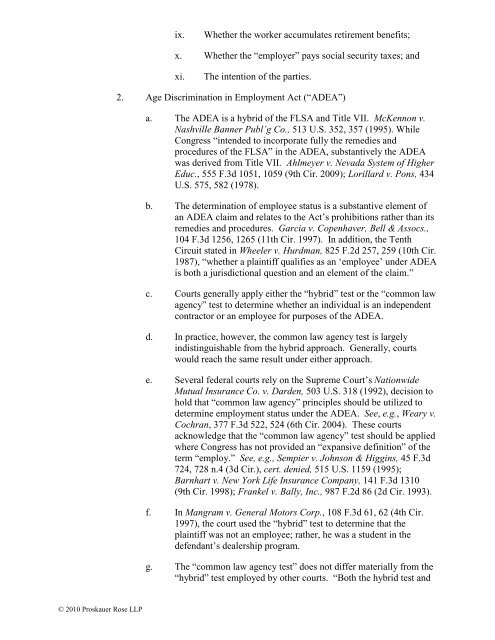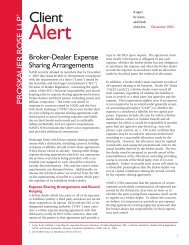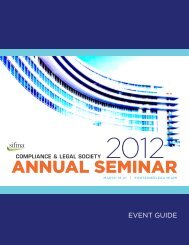Misclassification of Workers - Proskauer Rose LLP
Misclassification of Workers - Proskauer Rose LLP
Misclassification of Workers - Proskauer Rose LLP
Create successful ePaper yourself
Turn your PDF publications into a flip-book with our unique Google optimized e-Paper software.
© 2010 <strong>Proskauer</strong> <strong>Rose</strong> <strong>LLP</strong><br />
ix. Whether the worker accumulates retirement benefits;<br />
x. Whether the “employer” pays social security taxes; and<br />
xi. The intention <strong>of</strong> the parties.<br />
2. Age Discrimination in Employment Act (“ADEA”)<br />
a. The ADEA is a hybrid <strong>of</strong> the FLSA and Title VII. McKennon v.<br />
Nashville Banner Publ’g Co., 513 U.S. 352, 357 (1995). While<br />
Congress “intended to incorporate fully the remedies and<br />
procedures <strong>of</strong> the FLSA” in the ADEA, substantively the ADEA<br />
was derived from Title VII. Ahlmeyer v. Nevada System <strong>of</strong> Higher<br />
Educ., 555 F.3d 1051, 1059 (9th Cir. 2009); Lorillard v. Pons, 434<br />
U.S. 575, 582 (1978).<br />
b. The determination <strong>of</strong> employee status is a substantive element <strong>of</strong><br />
an ADEA claim and relates to the Act’s prohibitions rather than its<br />
remedies and procedures. Garcia v. Copenhaver, Bell & Assocs.,<br />
104 F.3d 1256, 1265 (11th Cir. 1997). In addition, the Tenth<br />
Circuit stated in Wheeler v. Hurdman, 825 F.2d 257, 259 (10th Cir.<br />
1987), “whether a plaintiff qualifies as an ‘employee’ under ADEA<br />
is both a jurisdictional question and an element <strong>of</strong> the claim.”<br />
c. Courts generally apply either the “hybrid” test or the “common law<br />
agency” test to determine whether an individual is an independent<br />
contractor or an employee for purposes <strong>of</strong> the ADEA.<br />
d. In practice, however, the common law agency test is largely<br />
indistinguishable from the hybrid approach. Generally, courts<br />
would reach the same result under either approach.<br />
e. Several federal courts rely on the Supreme Court’s Nationwide<br />
Mutual Insurance Co. v. Darden, 503 U.S. 318 (1992), decision to<br />
hold that “common law agency” principles should be utilized to<br />
determine employment status under the ADEA. See, e.g., Weary v.<br />
Cochran, 377 F.3d 522, 524 (6th Cir. 2004). These courts<br />
acknowledge that the “common law agency” test should be applied<br />
where Congress has not provided an “expansive definition” <strong>of</strong> the<br />
term “employ.” See, e.g., Sempier v. Johnson & Higgins, 45 F.3d<br />
724, 728 n.4 (3d Cir.), cert. denied, 515 U.S. 1159 (1995);<br />
Barnhart v. New York Life Insurance Company, 141 F.3d 1310<br />
(9th Cir. 1998); Frankel v. Bally, Inc., 987 F.2d 86 (2d Cir. 1993).<br />
f. In Mangram v. General Motors Corp., 108 F.3d 61, 62 (4th Cir.<br />
1997), the court used the “hybrid” test to determine that the<br />
plaintiff was not an employee; rather, he was a student in the<br />
defendant’s dealership program.<br />
g. The “common law agency test” does not differ materially from the<br />
“hybrid” test employed by other courts. “Both the hybrid test and




